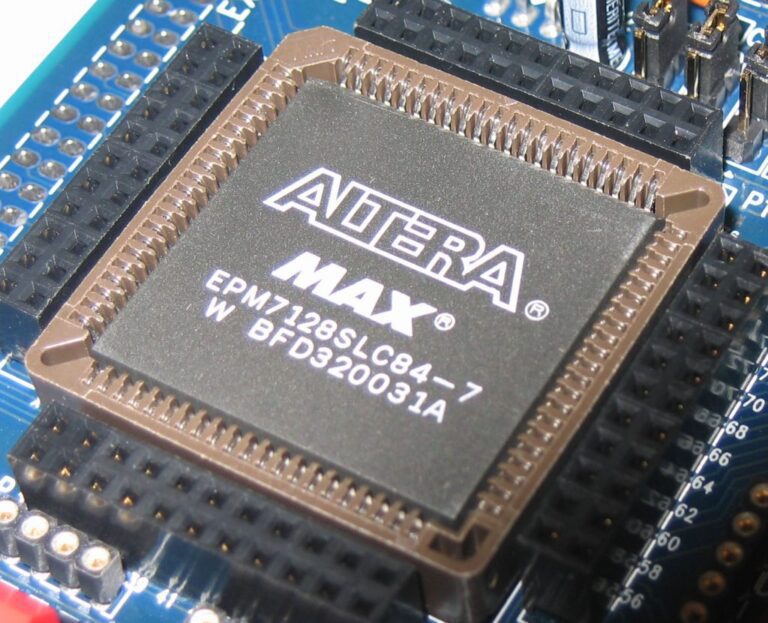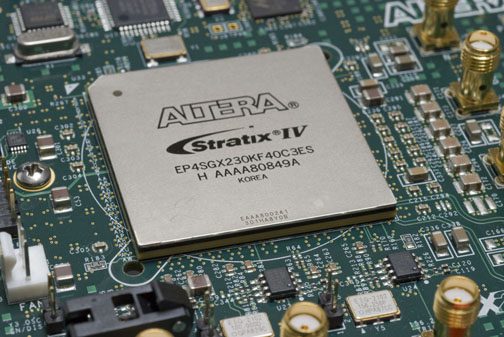In the field of digital electronics and programmable logic, two prominent devices stand out for their versatility and performance: Complex Programmable Logic Devices (CPLDs) and Field-Programmable Gate Arrays (FPGAs). Both CPLDs and FPGAs offer designers the ability to implement complex digital systems and provide flexibility in the face of evolving requirements. However, they differ in terms of architecture, capabilities, and optimal use cases.
Understanding CPLDs
Complex Programmable Logic Devices (CPLDs) are a type of programmable logic device that consists of a collection of simple programmable logic blocks, interconnects, and I/O pins. CPLDs are known for their relatively small size, low power consumption, and high-speed operation. They excel in applications that require deterministic, high-speed, and complex combinatorial logic. CPLDs are typically programmed using Hardware Description Languages (HDL) like VHDL or Verilog.
CPLDs offer a relatively small number of macrocells or logic blocks, which are capable of implementing combinational logic functions. These macrocells can be programmed to perform complex logic operations, such as AND, OR, XOR, and more. The interconnect matrix in CPLDs allows for flexible routing of signals between macrocells, enabling the designer to create the desired logic connections. Furthermore, CPLDs often provide additional functionality like flip-flops, registered outputs, and clock dividers, allowing for limited sequential functionality.

Complex Programmable Logic Device (CPLD). (Image source: Wiki)
Exploring FPGAs
Field-Programmable Gate Arrays (FPGAs) are reconfigurable integrated circuits that contain a vast number of configurable logic blocks (CLBs) interconnected through programmable interconnects. Unlike CPLDs, FPGAs are capable of implementing complex sequential circuits along with combinatorial logic due to the presence of flip-flops in each CLB. FPGAs offer high logic capacity, large-scale integration, and the ability to implement highly parallel architectures. They are suitable for applications that demand high-performance processing, such as digital signal processing, image and video processing, and high-speed networking.
FPGAs are known for their large logic capacity and ability to implement complex designs. The vast number of CLBs present in an FPGA allows for the implementation of intricate digital circuits, including both combinational and sequential logic. Each CLB typically consists of lookup tables (LUTs), flip-flops, and multiplexers, enabling the designer to create sophisticated designs. Additionally, FPGAs provide dedicated memory blocks, digital signal processing (DSP) blocks, and other specialized components that can be used to enhance the functionality of the design.

Field Programmable Gate Array (FPGA). (Image source: Wiki)
Architecture and Functionality
CPLDs and FPGAs differ significantly in terms of architecture. CPLDs typically have a relatively low number of macrocells or logic blocks that are designed to implement combinatorial logic. These macrocells are interconnected through a programmable interconnect matrix, allowing for relatively simple designs with limited sequential capabilities. CPLDs are well-suited for applications that require fast switching speed and deterministic behavior, such as glue logic, bus interfacing, and control functions.
FPGAs, on the other hand, offer a highly configurable architecture with a large number of CLBs interconnected through programmable interconnects. This architecture enables the implementation of both combinatorial and sequential logic, making FPGAs suitable for a wide range of applications. FPGAs provide the flexibility to create complex digital systems by utilizing the vast resources available within the device, including LUTs, flip-flops, memory blocks, and specialized components.
Design Flexibility and Resources
FPGAs offer more design flexibility compared to CPLDs. With their larger logic capacity, FPGAs can accommodate complex designs and incorporate multiple subsystems into a single device. FPGAs also provide abundant resources like memory blocks, high-speed I/Os, clock management circuits, and specialized peripherals, enabling the integration of diverse functionalities into a single chip. This flexibility allows designers to create highly customized and feature-rich digital systems.
CPLDs, while offering smaller logic capacities, are more power-efficient and cost-effective for simpler designs. CPLDs are well-suited for applications that require moderate logic complexity and low power consumption. They often find use in applications like system control, interface bridging, and small-scale digital circuits. CPLDs are also suitable for situations where cost is a significant factor, as they tend to be more affordable than FPGAs due to their simpler architecture and lower resource count.
Power Consumption and Cost
CPLDs generally consume less power compared to FPGAs. This advantage arises from their simpler architecture, smaller size, and lower I/O count. CPLDs are suitable for low-power applications and battery-operated devices where power consumption is a critical consideration. By using CPLDs, designers can reduce the overall power requirements of their systems, leading to extended battery life and energy efficiency.
In terms of cost, CPLDs are generally more affordable than FPGAs. The simplicity of the CPLD architecture and their smaller size result in lower manufacturing costs. CPLDs are often a cost-effective solution for simpler designs or projects with budget constraints. FPGAs, being more complex and versatile, tend to be more expensive, particularly for high-end devices with larger logic capacities and specialized features. When considering the cost aspect, designers must evaluate the complexity of their design requirements and balance it with the available budget.
Development Tools and Ecosystem
Both CPLDs and FPGAs are backed by a range of development tools, software frameworks, and IP libraries provided by their respective manufacturers. These tools assist designers in writing and verifying their designs, simulating functionality, and programming the devices. Popular vendors like AMD (formerly Xilinx), Intel (formerly Altera), and Lattice Semiconductor offer comprehensive toolchains and community support for both CPLDs and FPGAs.
These development tools provide features such as design entry, simulation, synthesis, place-and-route, and device programming. They also offer libraries of pre-designed IP blocks, enabling designers to leverage existing components and accelerate their design process. The availability of robust development tools and a supportive ecosystem is crucial for successful implementation and deployment of CPLD and FPGA designs.
Popular Manufactures of CPLDs
When it comes to Complex Programmable Logic Devices (CPLDs), several manufacturers have established themselves as industry leaders, each bringing their own strengths and innovations to the table. Microchip Technology, a prominent player in the CPLD market, has gained widespread popularity with its highly regarded CoolRunner series. Microchip’s CoolRunner CPLDs are known for their excellent balance between performance and low power consumption, making them ideal for power-sensitive applications. These CPLDs offer designers a versatile platform for implementing complex logic functions while minimizing power consumption. With their wide range of device densities and rich feature sets, the CoolRunner CPLDs can handle diverse application requirements, from simple logic functions to more complex designs.
Lattice Semiconductor is another well-regarded manufacturer that has made significant contributions to the CPLD landscape. The MachXO series from Lattice Semiconductor is highly regarded for its flexibility and ease of use, providing designers with an efficient platform for rapid prototyping and system integration. The MachXO CPLDs offer a comprehensive range of features, including low power consumption, high I/O count, non-volatile memory, and built-in security features. These capabilities make them suitable for a wide array of applications, from consumer electronics to industrial automation. Lattice Semiconductor’s innovative programming and configuration tools further simplify the development process, empowering designers to quickly bring their ideas to life.
Xilinx, a leading FPGA manufacturer, also offers CPLDs under the CoolRunner II series. These CPLDs combine Xilinx’s expertise in programmable logic with low power consumption, enabling designers to implement complex logic functions efficiently. The CoolRunner II CPLDs boast advanced features such as in-system programmability, advanced I/O capabilities, and robust performance. With their broad range of features and industry-leading performance, the CoolRunner II CPLDs have gained popularity across various industries, including telecommunications, automotive, and aerospace.
Altera, now a part of Intel, has also played a significant role in the CPLD market. Their MAX II series CPLDs offer a combination of high density, low power consumption, and reliable performance. These CPLDs provide designers with flexible logic solutions for a wide range of applications, from communications systems to industrial control. Intel CPLDs are known for their robust design tools and development kits, empowering designers to optimize their designs and streamline the development process.
These manufacturers, along with others like QuickLogic and NXP continue to drive advancements in CPLD technology, offering designers a diverse range of options for implementing flexible and efficient logic solutions. With their continued innovations and commitment to meeting evolving market demands, CPLD manufacturers play a crucial role in enabling the development of cutting-edge electronic systems across industries.
Popular Manufactures of FPGAs
When it comes to Field-Programmable Gate Arrays (FPGAs), several manufacturers have emerged as leaders in the industry, each bringing their own strengths and innovations to the table. Xilinx, a company that has consistently been at the forefront of the market, is known for its cutting-edge FPGA solutions. With a broad portfolio of FPGA offerings, ranging from entry-level devices to high-performance models, Xilinx caters to diverse application needs. Their FPGAs are widely utilized in sectors such as aerospace, defense, communications, and data centers. Moreover, Xilinx’s recent introduction of adaptive compute acceleration platforms, such as the Versal series, has positioned them as a leader in the field of AI and machine learning acceleration.
Intel, formerly known as Altera, is another prominent player in the FPGA market. Intel FPGAs are highly regarded for their reliability, performance, and scalability. They offer a comprehensive lineup of FPGAs that target a wide range of applications, including telecommunications, data centers, automotive systems, and industrial automation. Intel’s FPGAs are known for their ability to handle complex computations efficiently, making them suitable for demanding workloads.
Lattice Semiconductor, a veteran in the FPGA industry, specializes in low-power FPGAs and programmable logic devices. Their FPGAs are specifically designed to address power-sensitive applications, making them ideal for mobile devices, IoT devices, and edge computing solutions. Lattice FPGAs are known for their energy efficiency, small form factors, and ease of use. They offer a combination of low power consumption, small footprint, and affordability, making them popular choices for cost-sensitive and power-constrained applications.
Microsemi, now part of Microchip Technology, is another significant player in the FPGA market. Microsemi’s FPGAs excel in applications that require reliability, security, and high-speed performance. They are widely used in sectors such as aerospace, defense, and communications, where stringent requirements for reliability and security are crucial. Microsemi FPGAs are often deployed in mission-critical systems and applications where failure is not an option.
These manufacturers, among others, continue to drive advancements in FPGA technology, constantly pushing the boundaries of what is possible. With their diverse offerings and ongoing innovations, they play a crucial role in shaping the landscape of FPGA-based solutions across various industries, from high-performance computing and AI to mobile devices and IoT applications.
Choosing the Right Device
When deciding between CPLDs and FPGAs, several factors should be considered. If your design requires simple glue logic and interface bridging or if you need to implement time-critical control functions with low power consumption, CPLDs are a cost-effective choice. CPLDs excel in applications where fast switching speeds and deterministic behavior are paramount. They are often used in systems that require bus interfacing, protocol conversion, state machine control, or simple digital functions.
On the other hand, if your application demands high-performance processing, parallelism, complex algorithms, or substantial sequential logic, FPGAs provide the necessary resources and flexibility. FPGAs are suitable for data-intensive tasks such as digital signal processing, image and video processing, cryptography, artificial intelligence, and high-speed networking. FPGAs can handle large data sets and perform computations in parallel, making them ideal for applications that require extensive processing capabilities.
When choosing between CPLDs and FPGAs, consider the complexity of your design. CPLDs are well-suited for relatively simple designs with low logic complexity. They offer a cost-effective solution for small-scale projects or those with budget constraints. If your design requires a larger logic capacity, complex digital circuits, or integration of multiple subsystems, FPGAs are the better choice. FPGAs provide the flexibility to implement sophisticated designs, leverage extensive resources, and create highly customized and feature-rich digital systems.
Power consumption is another important factor to consider. CPLDs are generally more power-efficient than FPGAs due to their simpler architecture and lower resource count. If your application requires low power consumption or operates on battery power, CPLDs are a suitable option. FPGAs, while offering higher performance, typically consume more power due to their larger size, increased logic capacity, and additional resources. Consider the power constraints of your project and choose the device that aligns with your power requirements.
Cost is also a significant consideration. CPLDs are generally more affordable than FPGAs, making them an attractive option for projects with limited budgets or simpler designs. FPGAs, being more complex and versatile, tend to have higher costs, especially for high-end devices with advanced features and larger logic capacities. Evaluate your project’s budget and weigh it against the required functionality and complexity to make a cost-effective decision.
Consider the development tools and ecosystem provided by the device manufacturers. Both CPLDs and FPGAs have extensive toolchains, software frameworks, and community support. Evaluate the availability and quality of these resources, as they can significantly impact the design and development process. Look for comprehensive toolsets that offer design entry, simulation, synthesis, place-and-route, and programming capabilities. Additionally, consider the availability of libraries and IP blocks that can accelerate your design process and provide pre-designed components for faster implementation.
Conclusion
CPLDs and FPGAs are powerful programmable logic devices with distinct features, strengths, and applications. Understanding the differences between CPLDs and FPGAs is essential when selecting the appropriate solution for your digital design project. CPLDs are suitable for low-power, deterministic, and time-critical applications, offering fast switching speeds and cost-effective solutions. FPGAs excel in high-performance, data-intensive, and complex processing tasks, providing extensive resources, flexibility, and parallelism.
Consider factors such as speed, resources, power consumption, cost, and the complexity of your design requirements when making a decision. By carefully evaluating these aspects, you can choose the right device that aligns with your project’s needs, budget, and performance goals. Whether you opt for a CPLD or an FPGA, both devices offer immense possibilities for implementing innovative and highly functional digital systems.
Learn more at Sparkfun, HardwareBee, and FPGAKey.
Don’t fret – our IC & Semiconductor Sourcing Specialists can help you today. You can reach us on our Contact Page!





























